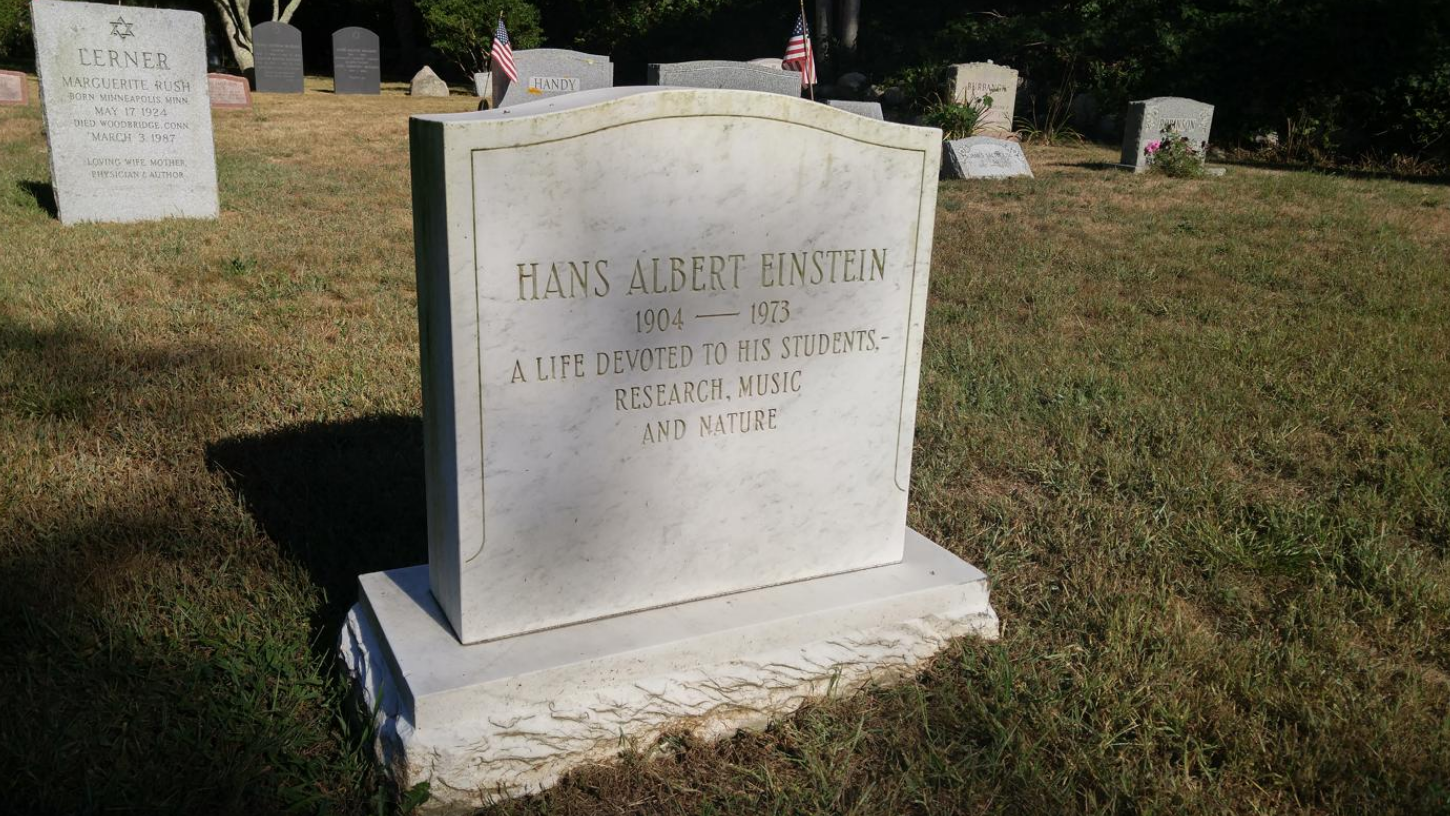- /aɪnˈstaɪn
- sediment
- hydraulic
Basic Information
(May 1904–Jul 1973)
Location: Bern, Switzerland
1. Introduction
Hans Albert Einstein (/aɪnˈstaɪn, -ˈʃtaɪn/ eyen-STYNE, -SHTYNE; May 14, 1904 – July 26, 1973) was a Swiss-American engineer and educator, the second child and first son of Albert Einstein and Mileva Marić. Hans A. Einstein was a professor of Hydraulic Engineering at the University of California, Berkeley,[1] and was recognized for his research on sediment transport.[2] His papers are held at the Water Resources Collections and Archives in the University of California, Riverside Libraries[3] and in the University of Iowa Libraries Special Collections and Archives.[4]
2. Early Life
Hans Albert Einstein was born on May 14, 1904 in Bern, Switzerland, where his father, Albert Einstein, worked as a clerk in the patent office. His father was of German-Jewish descent and his mother, Mileva Marić, Serbian-Orthodoxe. His younger brother, Eduard Einstein, was born in 1910 and died in 1965. The fate of his older sister, Lieserl Einstein, Albert Einstein's and Mileva Marić's first child, is unknown. Their parents divorced in 1919 after living apart for five years.
3. Career
Einstein followed his mother's and father's footsteps and studied at ETH, the Swiss Federal Institute of Technology, in Zurich, Switzerland. In 1926 he was awarded a diploma in civil engineering. From 1926 to 1930 he worked as a steel designer on a bridge project in Dortmund. In 1936 Hans Albert obtained the doctor of technical science degree. His doctoral thesis "Bed Load Transport as a Probability Problem" is considered the definitive work on sediment transport.[5]
Einstein's father, Albert, left Germany in 1933 to escape the virulently antisemitic Nazi threat. Heeding his father's advice, Einstein emigrated from Switzerland to Greenville, South Carolina, in 1938. He worked for the US Department of Agriculture, studying sediment transport from 1938 to 1943. He continued working for the USDA at the California Institute of Technology starting in 1943. In 1947 he took a position as associate professor of hydraulic engineering at the University of California, Berkeley. He advanced to full professor, and later professor emeritus. Einstein traveled the world to participate in hydraulic engineering conferences. He was at a symposium at Woods Hole in Massachusetts when he collapsed and died from heart failure on July 26, 1973.[6]
Einstein was honored by a Guggenheim Fellowship (1953), research awards from the American Society of Civil Engineers (1959 and 1960), the Berkeley Citation from the University of California (1971), the Certificate of Merit from the U.S. Department of Agriculture (1971), and a certificate of recognition for more than twenty years of devoted and distinguished service to Applied Mechanics Reviews by the American Society of Mechanical Engineers (1972).[7]
4. Personal Life
In 1927 Hans Albert Einstein married Frieda Knecht. Albert disapproved of Frieda much as his parents had of Mileva. Einstein and Frieda had four children:
- Bernhard Caesar Einstein (10 July 1930 – 30 September 2008),[8] who was a physicist and engineer.
- Klaus Martin Einstein (15 March 1933 – 5 January 1939),[9] died of diphtheria aged six.[10]
- David Einstein (16 October 1939 – 21 November 1939),[11] died aged one month.
- Evelyn Einstein (28 March 1941 – 13 April 2011), adopted.[12]
Frieda died in 1958, and Hans Albert later married neurochemist Elizabeth Roboz (1904–1995).[13]
Einstein was an avid sailor, frequently taking colleagues and family out for excursions on the San Francisco Bay. On his many field trips and academic excursions, he took thousands of pictures, many of which he developed himself and presented as slide shows. He also loved music, as denoted on his gravestone, and he played flute and piano.[14]
5. Death

Hans Albert Einstein died due to heart failure on July 26, 1973 (aged 69) in Woods Hole, Massachusetts, US.
The content is sourced from: https://handwiki.org/wiki/Biography:Hans_Albert_Einstein
References
- "University of California In Memoriam". http://www.lib.berkeley.edu/uchistory/archives_exhibits/in_memoriam/catalog/einstein_hans_albert.html.
- "University of California: In Memoriam, March 1976". http://texts.cdlib.org/view?docId=hb9k4009c7&doc.view=frames&chunk.id=div00013&toc.depth=1&toc.id=.
- Inventory of the Hans Albert Einstein Papers, 1937–1972 Online Archive of California http://www.oac.cdlib.org/findaid/ark:/13030/tf0779n5bx/?query=einstein
- "Papers of Hans Albert Einstein". http://www.lib.uiowa.edu/scua/msc/tomsc900/msc900/msc0900hanseinsteinpapers.html. Retrieved August 31, 2016.
- R. Ettema and C. F. Mutel (2014). Hans Albert Einstein: His Life as a Pioneering Engineer. Reston, VA: American Society of Civil Engineers Press. p. 298. ISBN 978-0-7844-7829-5. Accessed August 31, 2016.
- Küpper, Hans-Josef. "Short life history: Hans Albert Einstein". http://www.einstein-website.de/biographies/einsteinhansalbert_content.html. Retrieved August 31, 2016.
- Johnson, J. W., D. K. Todd and R. L. Wiegel. "Inventory of the Hans Albert Einstein Papers, 1937-1972". http://www.oac.cdlib.org/view?docId=tf0779n5bx;query=;style=oac4;view=admin#bioghist-1.8.4. Retrieved August 31, 2016.
- Bernahrt Caesar Einstein in: findagrave.com [retrieved 26 May 2016]. https://www.findagrave.com/memorial/143597188
- Klaus Martin Einstein in: findagrave.com [retrieved 26 May 2016]. https://www.findagrave.com/memorial/37102116
- "Einstein on Death of Six-Year Old Grandson". Shapell Manuscript Collection. Shapell Manuscript Foundation. http://www.shapell.org/manuscript.aspx?albert-einstein-writes-his-son-about-lifes-hardships.
- David Einstein in: findagrave.com [retrieved 26 May 2016]. https://www.findagrave.com/memorial/113768148
- Martin, Douglas (April 18, 2011). "Evelyn Einstein Dies at 70; Shaped by a Link to Fame". New York Times. https://www.nytimes.com/2011/04/19/us/19einstein.html?_r=0. Retrieved August 31, 2016.
- Dennis Overbye: Einstein in Love: A Scientific Romance [retrieved 26 May 2016]. https://books.google.com.pe/books?id=nPkdbO1SY60C&pg=PT405&lpg=PT405&dq=Frieda+Knecht+einstein+children&source=bl&ots=NU17rcuQhp&sig=0gltxHsmfUm3DPVv5UMrzwK6Hko&hl=es&sa=X&ved=0ahUKEwjnlaPa-PjMAhWK4SYKHeFzDDQ4ChDoAQgiMAE#v=onepage&q=Frieda%20Knecht%20einstein%20children&f=false
- R. Ettema and C. F. Mutel (2014). Hans Albert Einstein: His Life as a Pioneering Engineer. p. 183. ISBN 978-0-7844-7829-5.
